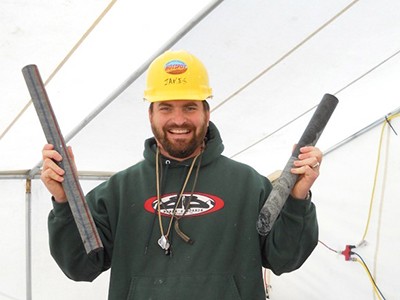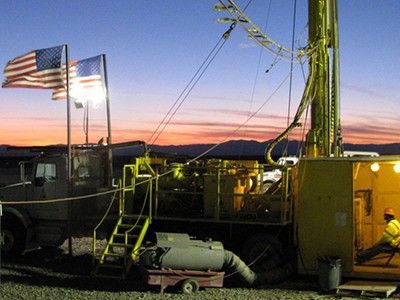In Hot Water: USU Geologists Probe Snake River Plain's Energy Potential
At a Project Hotspot drill site on Idaho's Mountain Home Air Force Base, USU alum James Kessler PhD’14, an employee of Houston’s Oxo Petroleum, holds core samples. Kessler and USU colleagues published finding in 'Lithosphere.’
The thirsty farm fields of Idaho benefit from fresh, cold waters flowing from nearby mountains into the aptly named Snake River that winds its way through the Gem State and neighboring states. Yet deep underneath this thick blanket of chilly ground water are geothermally heated waters that could hold potential for geothermal energy.
Utah State University geologists examined a scientific borehole drilled about a mile into the Snake River Plain at Idaho’s Mountain Home Air Force Base, which lies in the tracks of the Yellowstone Hotspot. Recent USU grad James Kessler, PhD ’14; current undergrads Mikaela Pulsipher and Fallon Rowe, graduate student Jerome Varriale and faculty members Kelly Bradbury, Jim Evans and John Shervais, along with colleague Doug Schmitt of the University of Alberta, reported their findings in the April, 2017 issue of Lithosphere.
“The temperature rise was really high below the fresh water zone,” says Evans, professor in USU’s Department of Geology. “This is probably due to a thick layer of sediment that creates an insulating cap, as well as fractured and faulty rocks that form a conduit to focus the slow of thermal water to the drill site.”
At this point, he says, the borehole is a ‘proof of concept’ regarding where commercially possible amounts of thermal waters are available.
“We found a rather complicated set of fractures and faults at depth,” Evans says. “These are similar to sites in Nevada, where thermal waters are also found and where big geothermal plants have been constructed.”
Learning more about the geology of the borehole’s basaltic rocks and determining how characteristic fractures form during drilling could help scientists find geothermal fluids.
“This knowledge could help us gauge the hotspot’s potential for viable geothermal energy production,” Evans says.
The team’s research is part of Project Hotspot, a project funded by the U.S. Department of Energy under the 2009 American Recovery and Reinvestment Act and supported by the International Continental Drilling Program, the U.S. Air Force, USU, the Snake Play Fairway Project, an ExxonMobil Geoscience Research Grant and a current DOE grant to Shervais.
Related Links
“Heat Seekers: USU Geologists Get DOE Grant for Geothermal Exploration,” Utah State Today
USU Department of Geology
USU College of Science
Contact: Jim Evans, 435-797-1267, james.evans@usu.edu
Writer: Mary-Ann Muffoletto, 435-797-3517, maryann.muffoletto@usu.edu
A worker, lower right, monitors a Project Hotspot drill site on Idaho's Snake River Plain, where USU geologists are investigating the area’s potential for geothermal energy production.
TOPICS
Research 877stories Sustainability 145stories Energy 102stories Rivers 101stories Geosciences 74storiesComments and questions regarding this article may be directed to the contact person listed on this page.








